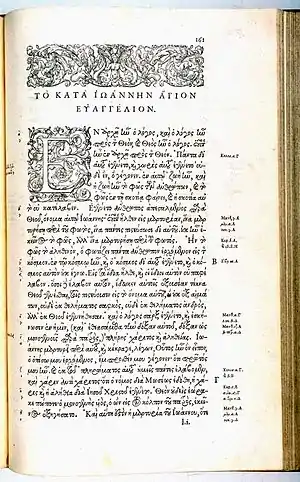Grecs du roi
Les grecs du roi are a celebrated Greek typeface designed by Claude Garamond in 1541 and containing a very large number of ligatures.

The grecs du roi were ordered by Robert Estienne on behalf of King Francis I of France. The design was based on the handwriting of the Cretan copyist Angelo Vergecio, and include a vast variety of alternate letters and ligatures to achieve this.[2][3][4][5] Arthur Tilley calls the resulting books "among the most finished specimens of typography that exist".[6]

The grecs du roi design placed significant demands on printers, since it requires a choice among the many possible types for every word, in contrast to Latin-alphabet general-purpose typefaces which do not attempt to simulate handwriting as closely. Most following typefaces for Greek have been much simpler. Gerry Leonidas, a leading expert on Greek typesetting, has commented that Vergecio's handwriting "has all the marks of a script that is unsuitable for conversion to [printing]. That it was the model for the widely-copied grecs-du-roi was, with hindsight, unfortunate."[7]
Digitization
Digital versions of the Grecs du roi are available.
A commercial OpenType font from Anagrafi Fonts, KS GrequeX, includes over 1100 glyphs and ligatures.[8]
There is a free digital font, Grecs du roi WG, without any ligatures.[9]
See also
References
- Valerie R. Hotchkiss, Charles C. Ryrie (1998). "Formatting the Word of God: An Exhibition at Bridwell Library". Archived from the original on 2009-07-27. Retrieved 2010-10-13.
- "Garamont's early career: the grecs du roi". French Ministry of Culture. Retrieved 3 December 2015.
- "The Greek Typefaces". French Ministry of Culture. Retrieved 3 December 2015.
- Mosley, James. "Porson's Greek type design". Type Foundry. Retrieved 30 January 2016.
- Elizabeth Armstrong (28 April 2011). Robert Estienne, Royal Printer: An Historical Study of the Elder Stephanus. Cambridge University Press. p. 52. ISBN 978-0-521-17066-6.
- Tilley, Arthur (1900). "Humanism under Francis I" (PDF). The English Historical Review. 15 (59): 456–478. doi:10.1093/ehr/xv.lix.456.
- John D. (ed.). Berry (2002). Language Culture Type: International Type Design in the Age of Unicode. ATypI. pp. 80–3. ISBN 978-1-932026-01-6.
- https://www.anagrafi.com/Fonts/KSGrequeX
- https://www.dafontfree.net/freefonts-grecs-du-roi-wg-f70601.htm
External links
- -- Konstantinos Siskakis's digitization
- Graphê, association pour la promotion de l'art typographique -- includes a photo of the punches for les Grecs du roi, Vergecio's manuscript, and the first book printed with the Grecs du roi.
